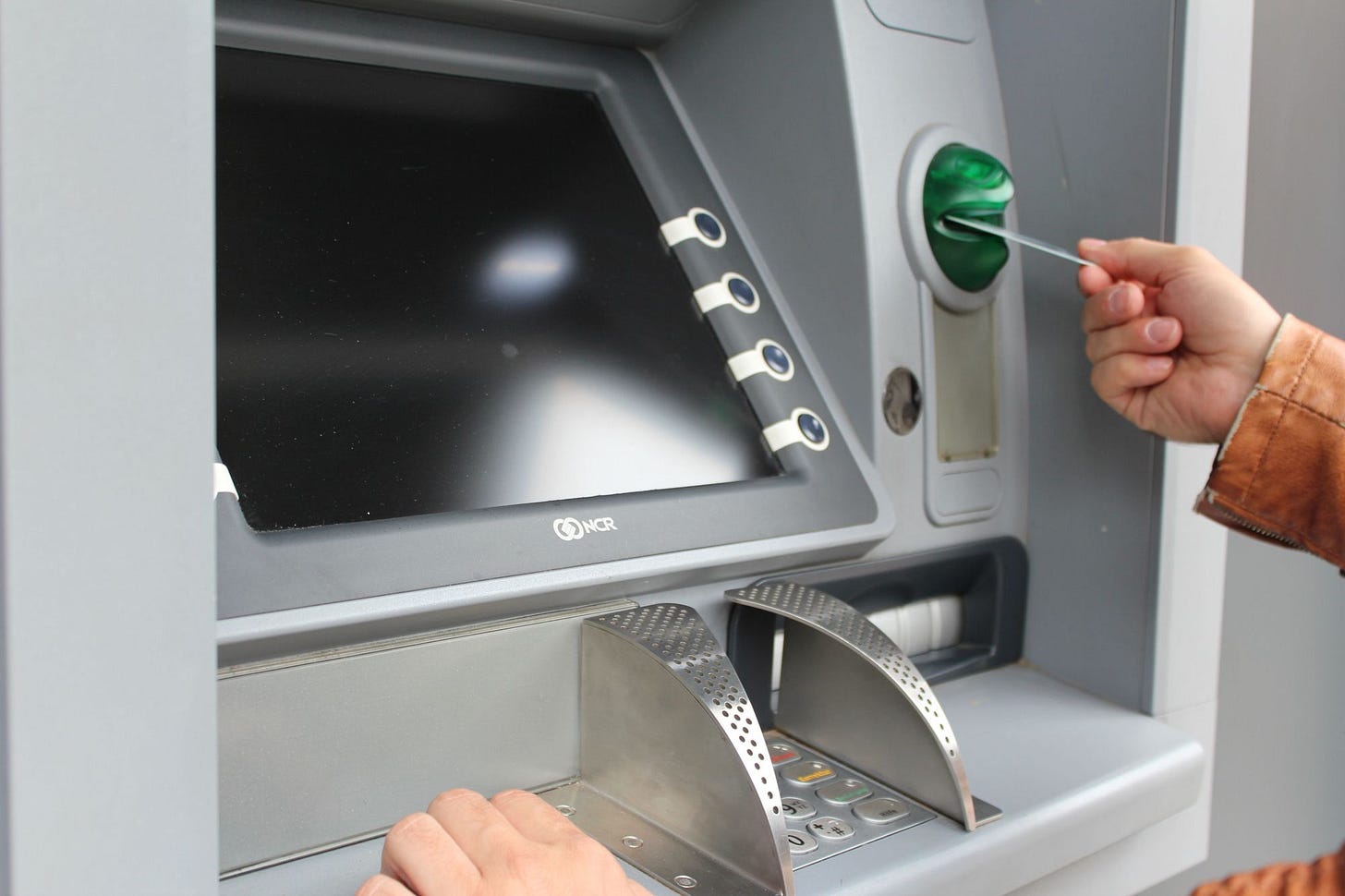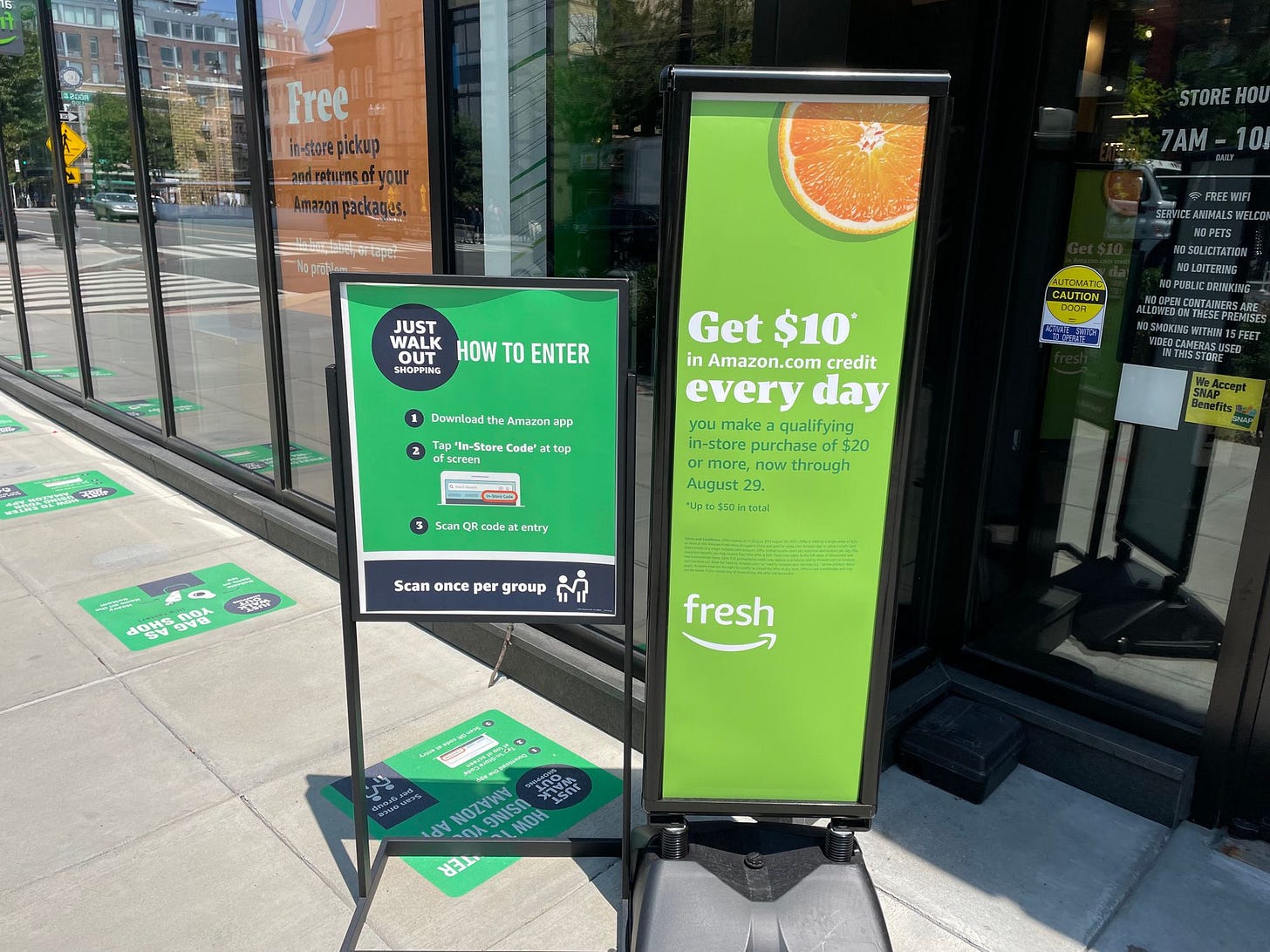Will Amazon’s no-checkout technology destroy jobs?
Amazon’s plan to abolish checkout lanes could actually create jobs.

Recently I wrote about Amazon’s Just Walk Out technology: Instead of checkout lanes, the Amazon Fresh store in Washington DC has cameras on the ceiling and weight sensors on the shelves to automatically track customer selections. This allows the customer to “just walk out” and get a bill by email later.
The technology, which is being tested at several of Amazon-branded grocery and convenience stores, has made some labor leaders nervous. Last year, for example, the president of the United Food and Commercial Workers Union described the technology as “part of a ruthless strategy to eliminate as many good jobs as possible.”
Obviously, widespread adoption of no-checkout technology would mean fewer people working as cashiers. But it’s not so obvious that adoption of the technology would lead to a net reduction in grocery industry jobs. The technology might shift labor to other parts of the store. It might also increase the total number of stores. If there are job losses, they are likely to happen gradually enough that they can be accommodated through attrition rather than mass layoffs.
We also shouldn’t ignore the crucial role of macroeconomic policy in the labor market. The Federal Reserve and other economic policymakers are responsible for keeping economy-wide employment on an even keel. If jobs decline in one sector, the Fed can and should boost demand to help create jobs in other sectors. So with competent macroeconomic management, labor-saving technology like Just Walk Out can be good for almost everyone.
ATMs destroyed some bank teller jobs, but created others

Let’s start with some historical perspective. The 1980s and 1990s saw a proliferation of automatic teller machines (ATMs) in the banking industry. You might have expected that to lead to a rapid decline in bank teller jobs. But that’s not what happened, as the economist James Bessen documented in his 2015 book Learning by Doing.
Bessen estimates there were roughly 400,000 people working as bank tellers in 1980. Over the next 20 years, as ATMs became commonplace, the number of bank tellers declined modestly, to around 340,000. Then the number of tellers actually rebounded in the early 2000s. Bessen found that by 2013, there were more tellers than there had been 33 years earlier.
What happened? While the number of tellers per bank branch did decline between 1988 and 2004 (Bessen estimates it fell from around 20 employees per branch to around 13), the “number of urban commercial bank branches increased 43 percent” during the same period. And that wasn’t a coincidence.
As ATMs proliferated, customers came to expect their bank to have a nearby branch with 24-hour ATM service. So banks raced to open additional branches—something that was financially viable thanks to the cost savings of ATMs. The remaining tellers in each branch focused on complex transactions an ATM couldn’t handle, on old-fashioned customers who didn’t want to use an ATM, and on upselling customers on high-value financial products like loans and retirement advice.
Over the last decade, the number of teller jobs has declined more rapidly than before. This may reflect the impact of online banking and payment apps like Venmo that have enabled younger customers to cut back on the use of cash—and hence on the need to visit a bank or ATM at all.
So it goes too far to say that new innovations never cost jobs. But the impact of new technologies on the labor market is complex and hard to predict. Sometimes new technologies change the nature of a job rather than eliminating it altogether. In other cases, labor-saving technology enables a product to become cheaper, which causes customers to buy more of it.
Indeed, Bessen writes that this is what happened in one of the first industries to be automated—textiles. Over the course of the 19th Century, new weaving machines greatly expanded the amount of cloth a worker could produce per hour. Yet employment in the textile industry went up, not down, over the course of the 19th Century because demand for cloth was elastic: the cheaper cloth got, the more customers bought.
Fewer checkout clerks, more grocery workers?
A striking thing about the Amazon Fresh store that opened in DC last month is that it’s significantly smaller than a conventional grocery store. That might reflect the limitations of Amazon’s Just Walk Out technology. But it also points to some of the ways no-checkout technology could change the economics of the grocery industry.
Today, the grocery industry is dominated by stores that are big, cheap, and not especially convenient. Customers sometimes drive long distances to get to the grocery store and wait in long lines to check out. Because each trip takes a long time, it makes sense for customers to do big, infrequent trips—perhaps once a week.
Skipping the checkout line will let customers get in and out of a grocery store more quickly. Moreover, eliminating checkout lanes reduces a store’s overhead (both in terms of payroll and square footage) which could make smaller stores economically viable.
So Just Walk Out technology could have an impact on the grocery industry similar to the impact ATMs had on the banking industry. Grocery chains could open more, smaller stores to be closer to their customers: stores like the Amazon Fresh location I visited. This, along with the ability to skip checking out, would make shopping trips faster, which would encourage customers to make a larger number of smaller trips.
With customers coming into the store frequently, stores should be able to up-sell them more on high-margin fresh and prepared items: things like pre-washed salads, pre-cut fruits, meal kits with fresh ingredients. While stores will have fewer people manning checkout lanes, they might have more people preparing these convenience items. That, along with the larger number of stores, could mean more people working in the grocery industry.
A similar point applies to another Amazon Fresh speciality: grocery delivery. More stores would mean a shorter drive for each delivery. The same technology that lets customers check out faster would let grocery pickers complete a customer’s order more quickly. Amazon is also experimenting with a variety of robotic delivery technologies, which could eliminate the need for a human delivery driver.
These innovations would mean less labor is required per delivery. But if technology makes delivery services cheaper and more convenient, a lot more people could start using them. In 2020, deliveries accounted for only 10 percent of grocery industry revenues, so grocery delivery has a lot of headroom. Stores will still need workers to take items off of shelves and package them for delivery. So the number of people working on grocery deliveries might go up rather than down. Or at a minimum, it’s unlikely to decline as much as pessimists expect.
Macroeconomic policy matters

Ultimately, what we should care about is not the fate of any particular job category but whether workers in general have better opportunities over time. A gradual decline of jobs in one industry isn’t a big deal if the economy is generating plenty of new jobs for workers with similar levels of skills and education.
And something that’s often overlooked in discussions about automation and the labor market is the role played by monetary policy.
It’s easy to get bogged down in technical details, but at a high level the Federal Reserve controls the amount of money in circulation. If the Fed injects more cash into the economy, people have more cash in their pockets and some of them spend it. The extra spending stimulates economic activity and creates additional jobs.
But this only works if the economy has “slack.” If the economy is running close to capacity, then pumping in more money will mostly generate inflation rather than boosting output.
And the most important scarce resource is labor, which is why this is often described as a tradeoff between unemployment and inflation. If the economy has a lot of unemployed or underemployed workers, then monetary stimulus is likely to boost economic output—otherwise it will just cause inflation.
So suppose the analysis of the previous section is totally wrong, and Just Walk Out technology turns out to be a massive job-destroyer, with hundreds of thousands of grocery store cashiers getting thrown out of work in just a few years. All those layoffs would have a disinflationary impact. Industries that might otherwise have faced labor shortages would be able to hire laid off cashiers. The extra idle workers would ease pressure for higher wages, which in turn would reduce upward pressure on the prices business charge consumers.
And this, in turn, would give the Fed more room to stimulate the economy without worrying about inflation. The extra stimulus, and resulting job creation, would help idled grocery workers find new jobs quickly.
In practice, of course, the Fed doesn’t tailor its policies to the actions of any particular industry. The US economy has hundreds of different industries, and at any given time, some are expanding and others are contracting. But the Fed does closely monitor aggregate economic statistics that reflect labor market trends across all industries. So layoffs in any one industry should nudge the Fed in a dovish direction—at least a little bit.
Conventionally, the Fed boosts the economy by lowering interest rates, but that becomes difficult to do when short-term interest rates get close to zero. Economists disagree about whether the Fed “runs out of ammunition” in this kind of situation, or whether unconventional monetary policy remains effective.
My own view is that this problem is over-stated, and monetary policy remains fairly effective even when interest rates are near zero. But either way, a similar analysis applies to Congress, which can always stimulate the economy by running deficits.
And this is why popular worries about a jobless dystopian future don’t make sense. Pessimists worry that a succession of innovations like Just Walk Out could raise worker productivity but gradually put more and more workers out of work. But this is only a possibility if the Fed and Congress fail to do their jobs, repeatedly, over the course of many years. With appropriate macroeconomic policies, improved worker productivity will yield rising living standards rather than higher unemployment rates.


